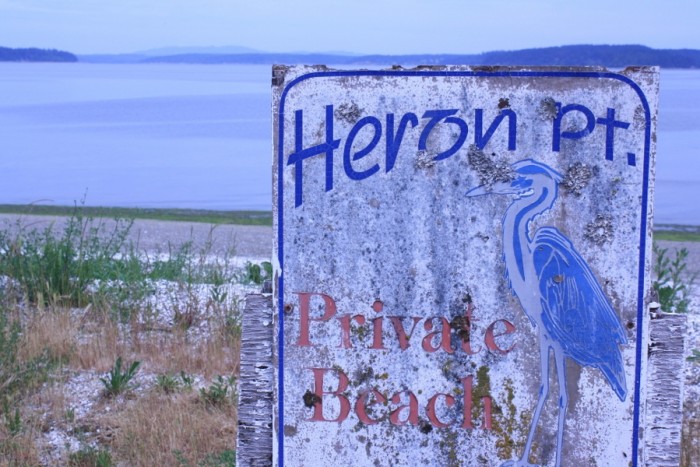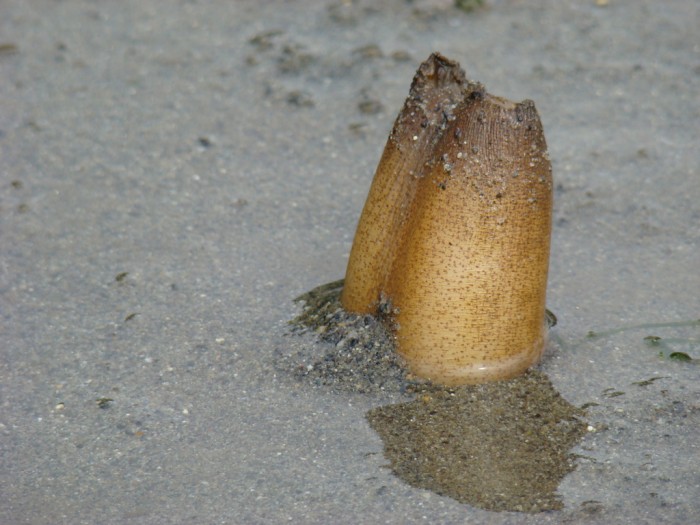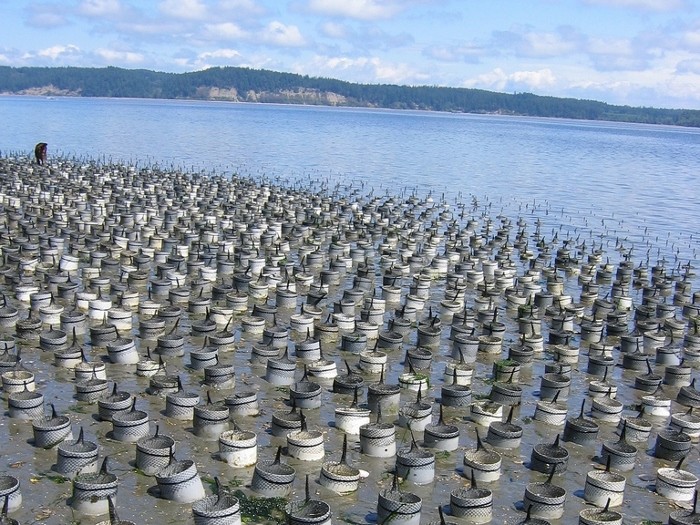
As the tide comes in on the Key Peninsula, you can hear critters slink and scurry to suck up what remains of the water quickly leaching from the exposed sand. Washington’s lively shorelines have made tidelands here and throughout the state attractive candidates for a new initiative that would open up a portion of public land for a practice known as geoduck aquaculture.
An unusual clam, a new practice
Geoducks, pronounced gooey-duck, are a large species of clam that live in the muck of Washington’s tidelands. The average size is about two pounds and some describe its unusual appearance as “phallic.” Many individuals head to Washington coasts year-round to collect a few of the bivalves for their own culinary enjoyment.
But new practices to boost commercial harvesting of the geoduck is making some Washingtonians concerned about shoreline environments where these unique and offbeat bivalves grow.
So far, commercial geoduck harvesting has been restricted to privately owned lands. For the first time, the state Department of Natural Resources is leasing a section of state-owned land. This will allow members of the shellfish industry to plant immature geoduck “seeds” for later harvest, a practice known as geoduck aquaculture.
Geoduck harvest has been common on Washington beaches for years. Commercial geoduck harvesting began on private tidelands in the 1970s, and tribes have raked them in for much longer. Geoduck exports to Japan and China in the late 1970s brought an international spotlight to the clams, and established contact with what would become a major consumer of the crop.
This month, the Washington State Department of Natural Resources auctioned 14 quotas in locations scattered around Central Puget Sound, the Hood Canal, and Hood Head East. This auction is part of the state’s wildstock fishery, and will consist of deepwater plots on privately owned land.

But in addition to the wildstock population, the shellfish industry has been working to boost harvests using aquaculture on private tidelands.
This year marks the first year that state lands will be leased for aquaculture, assuming all required permitting process are successfully completed. Brad Pruitt, a representative from Washington’s Department of Natural Resources, says that permitting is now underway, but adds that it’s unlikely anything will be finalized before the end of summer.
An important export
According to the National Marine Fisheries Service, the U.S. Customs counted over five million kilograms of geoduck leaving Washington last year, for a total of $75.8 million in geoduck exports. Of that amount, $69.5 million were made in shipments to China and Vietnam alone. Increasing demand has encouraged shellfish farmers to pressure the state to expand access to geoduck beds.
Meat from a geoduck is considered a delicacy in China and it can be sold for around $100 per pound in foreign markets. Stateside, companies bid hundreds of thousands of dollars to gain access to plots of land for harvesting.
Increasing geoduck aquaculture would create jobs, generate more revenue, and export a unique piece of Washington’s culture. It also has the potential to free up naturally occurring harvest. This benefits local tribes, which have a right to 50 percent of this geoduck population. The tribes are very involved in the state’s shellfish industry.
Though economic impacts of a growing aquaculture industry look promising, some are concerned about the environmental impacts of increased geoduck farming. Farming methods use PVC pipes to protect geoduck seeds during their first year of growth, and the pipes are covered with large nets that can ensnare wildlife.

Some are concerned by those practices, along with the use of pressurized water guns that liquefy sand and allow harvesters to wade waist-deep in muck. Despite support from the shellfish industry and state agencies, a small but influential opposition is calling for more stringent limitations on geoduck aquaculture.
Concerns arise
Perhaps the most vocal opponents to geoduck aquaculture are those involved with Protect our Shoreline, a community-run nonprofit fighting to limit aquatic farming.
Group founder Laura Hendricks says group members have seen a near-removal of native species in areas near aquaculture plots. Protect our Shoreline and other groups have urged for a very cautious approach to aquaculture.
“We’re not saying no aquaculture, we just want to know where they are and how many,” Hendricks said.
Washington Sea Grant looked into the issue, starting a series of studies to measure and assess how planting geoduck crops might affect the local environment. That research, which began in 2007, has not yet concluded, but the scientists involved say that so far no red flags have been raised. Significant short term alterations have been noted, but habitats have been shown to recuperate after farming gear has been withdrawn, they say.
Community activism has placed commercial shellfisheries under close public scrutiny. In response to complaints about the possibility of negative environmental impacts caused by current geoduck harvesting methods, some commercial fisheries have changed their practices.
Taylor Shellfish, the country’s largest shellfish farmer, gained approval for use of a new pesticide, imidacloprid, mid-April. But, after substantial backlash, the company caved to public opinion and will not use it.
Muddy waters
Aquaculture is a new endeavor, so it’s natural for people to have concerns about unforeseen consequences. The organized opposition to the practice had helped curb drastic changes in the aquaculture industry, before it dives head-first into muddy waters.
But with mounting scientific evidence showing temporary and limited environmental impacts, it looks like our best option for getting answers is to try it and see what happens.


Jesse, the Washington Sea Grant study ended a couple of years ago, but called for more study. You can find it online if you search for it. Also, aquaculture is not a “new” endeavor. The laws of our state on tidelines established at our inception were because of aquaculture going on at that time. Thanks.